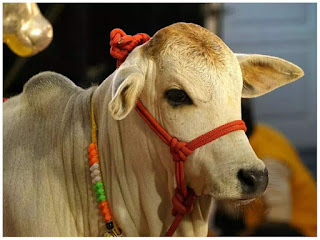Cows, revered as sacred beings, hold an exalted status in the cultural and religious fabric of India. The historical significance of cows in this ancient land extends far beyond mere economic or agricultural roles. Rooted in the country's diverse traditions and spiritual beliefs, the veneration of cows has shaped societal values, agricultural practices, and even the culinary preferences of the nation. This article explores the deep historical roots and cultural importance of cows in India, shedding light on the enduring significance of these gentle creatures.
Cows in Ancient Scriptures:
The sanctity of cows finds its earliest roots in ancient Indian scriptures. The Rigveda, one of the oldest texts in Hinduism, extols the virtues of the cow and considers it a symbol of non-violence, purity, and abundance. In Rigveda, the cow is referred to as "aghnya," meaning not to be killed, highlighting its sacred and inviolable nature.
Hinduism and the Holy Cow:
Hinduism, the predominant religion in India, places the cow at the center of its religious beliefs. The revered status of the cow is intertwined with the concept of "ahimsa," or non-violence, which is a fundamental tenet of Hindu philosophy. The cow, considered a gentle and nurturing creature, embodies the principles of compassion and kindness.
Lord Krishna and Cows:
The historical and mythological narratives of India are replete with stories that highlight the close association between gods and cows. Lord Krishna, one of the most revered deities in Hinduism, is often depicted as a cowherd, symbolizing the harmonious relationship between humans and cattle. The episode of Krishna's childhood, where he lovingly tends to the cows in the pastures of Vrindavan, is a cherished tale that reinforces the sacred bond between humans and cows.
The Symbol of Motherhood and Prosperity:
In Indian culture, the cow is often equated with the mother. The imagery of the cow nurturing and providing sustenance is deeply ingrained in the collective consciousness. The cow's milk, an essential part of the Indian diet, is seen as a symbol of nourishment and prosperity. In this context, the cow is not merely an animal but a maternal figure, embodying selfless care and abundance.
Cows in Rituals and Festivals:
The importance of cows transcends everyday life and extends to various religious rituals and festivals in India. Cow worship is an integral part of festivals like Govardhan Puja, where the cow is honored for its role in sustaining life and agriculture. In some regions, cows are adorned with garlands and vermillion during religious ceremonies, symbolizing their divine significance.
Economic Contributions of Cows:
While the religious and cultural aspects of cow veneration are paramount, the economic contributions of cows in ancient India should not be overlooked. Cows were essential to agricultural practices, providing not only milk but also serving as draught animals for plowing fields. Their dung was a valuable resource for fuel and fertilizer, emphasizing the holistic role of cows in sustaining agrarian communities.
The Decline of the Vedic Economy:
The decline of the Vedic economy and the advent of foreign invasions brought about significant changes in the socio-economic landscape of India. The traditional agrarian economy, where cows played a central role, gave way to new systems of governance and trade. Despite these transformations, the reverence for cows endured, finding expression in various aspects of daily life.
Cows in Colonial India:
During the colonial period, the British administration in India implemented policies that had a profound impact on the agrarian economy and the treatment of cows. The introduction of commercial agriculture and the imposition of taxes on land led to changes in land use, affecting traditional grazing lands for cattle. Additionally, the slaughtering of cows for meat consumption became a contentious issue, sparking tensions between the colonial rulers and the local population.
Cow Protection Movements:
The colonial period also witnessed the emergence of cow protection movements in response to perceived threats to the sacred animal. Various social and religious reformers, including leaders like Dayananda Saraswati and Swami Vivekananda, actively advocated for the protection of cows. These movements laid the groundwork for later legislative measures aimed at preventing cow slaughter.
Legal Measures for Cow Protection:
Post-independence, the Indian government recognized the cultural and religious significance of cows and enacted laws to protect them. Several states in India have implemented stringent measures against cow slaughter, reflecting the commitment to uphold the sanctity of the cow in the legal framework. The legal provisions, however, have sparked debates around issues of personal choice, economic considerations, and the need for humane treatment of animals.
Contemporary Challenges and Opportunities:
In the present day, the historical significance of cows in India faces challenges arising from urbanization, industrialization, and changing dietary preferences. The rapid expansion of cities has led to a reduction in grazing lands for cattle, impacting their traditional way of life. Balancing the need for economic development with the preservation of cultural values presents a complex challenge for policymakers.
Promoting Sustainable Agriculture:
Efforts to address contemporary challenges involve promoting sustainable agricultural practices that respect the well-being of cows. Organic farming, agroecology, and ethical dairy practices are gaining traction as viable alternatives that prioritize the health of the environment and the animals. By integrating modern agricultural technologies with traditional wisdom, India has the potential to strike a harmonious balance between progress and cultural preservation.
Final Words by Sarvdevmayi Goshala:
The historical significance of cows in India is deeply rooted in the cultural, religious, and economic fabric of the nation. From the Vedic scriptures to the present day, the cow has been more than just a domesticated animal; it has been a symbol of divinity, compassion, and abundance. Understanding and preserving this sacred bond between humans and cows is essential for maintaining the rich tapestry of India's cultural heritage. In navigating the challenges of the modern world, India has the opportunity to embrace sustainable practices that honor both tradition and progress, ensuring a harmonious coexistence with its revered bovine companions.


